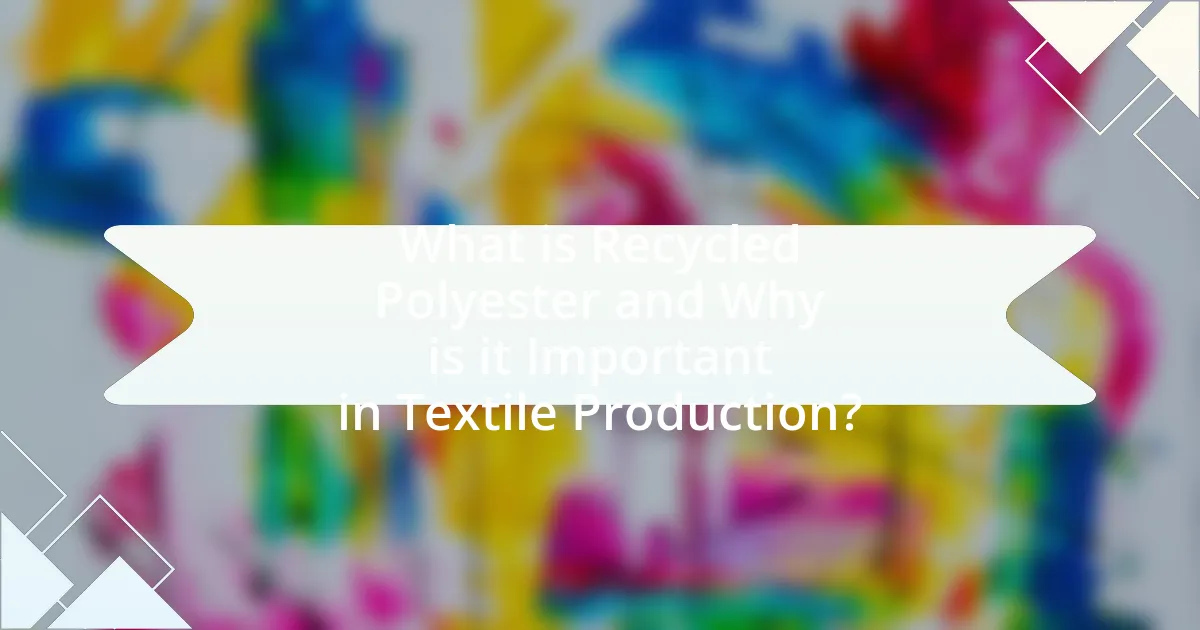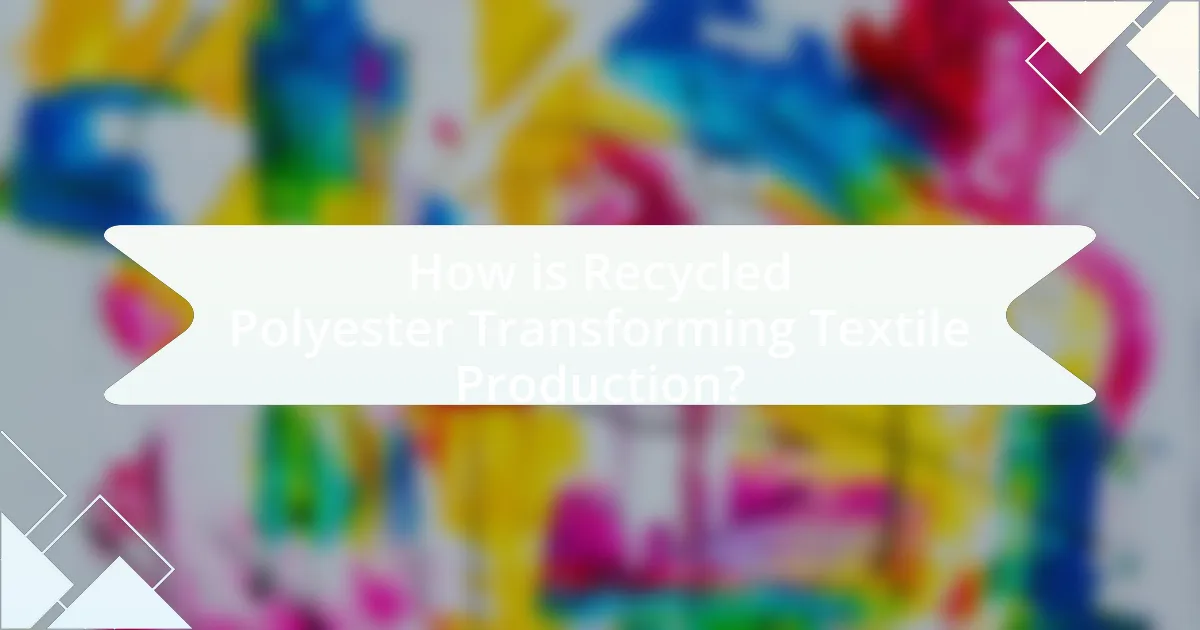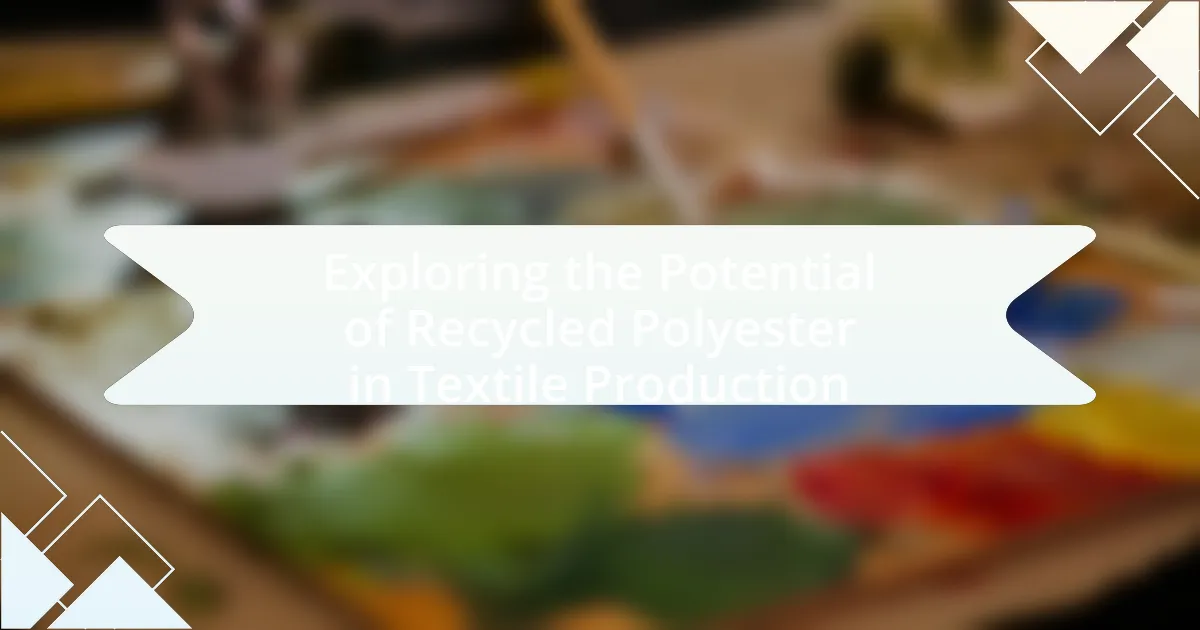Recycled polyester is a fabric derived from recycled plastic bottles and waste, playing a crucial role in sustainable textile production by reducing environmental impact and resource consumption. The article explores the manufacturing process of recycled polyester, its environmental benefits, and the challenges it faces in the textile industry. It highlights innovations in recycling technology, the integration of recycled polyester by leading brands, and future trends that indicate a growing demand for sustainable materials. Additionally, the article discusses practical steps brands can take to implement recycled polyester, including sourcing, partnerships, and quality assurance measures.

What is Recycled Polyester and Why is it Important in Textile Production?
Recycled polyester is a type of fabric made from recycled plastic bottles and other plastic waste, which is processed to create fibers for textile production. Its importance in textile production lies in its ability to reduce environmental impact by diverting plastic waste from landfills and oceans, thereby decreasing pollution and resource consumption. According to the Textile Exchange, using recycled polyester can save up to 59% in energy consumption compared to virgin polyester production, highlighting its role in promoting sustainability within the fashion industry.
How is Recycled Polyester Made?
Recycled polyester is made by processing plastic waste, primarily PET (polyethylene terephthalate) bottles and containers. The production process begins with collecting and sorting plastic waste, followed by cleaning and shredding it into small flakes. These flakes are then melted and extruded to form new polyester fibers. This method significantly reduces the need for virgin polyester, conserving resources and minimizing environmental impact. According to the Textile Exchange, using recycled polyester can save up to 60% of the energy required to produce virgin polyester, highlighting its sustainability benefits.
What materials are used to create Recycled Polyester?
Recycled polyester is primarily created from post-consumer plastic bottles and other plastic waste. The process involves collecting these plastics, cleaning them, and then breaking them down into small flakes. These flakes are subsequently melted and extruded into fibers, which can be woven or knitted into fabric. According to the Textile Exchange, using recycled polyester reduces the need for virgin polyester production, thereby conserving resources and minimizing environmental impact.
What processes are involved in recycling polyester?
The processes involved in recycling polyester include collection, sorting, cleaning, shredding, and reprocessing. Initially, post-consumer polyester products, such as plastic bottles or textile waste, are collected and sorted to separate polyester from other materials. After sorting, the polyester is cleaned to remove contaminants like labels and residues. The cleaned polyester is then shredded into smaller pieces, which facilitates further processing. Finally, the shredded polyester is reprocessed through methods such as mechanical recycling or chemical recycling, where it is transformed back into usable polyester fibers or pellets for new textile production. This recycling process significantly reduces the need for virgin polyester, thereby conserving resources and minimizing environmental impact.
What are the Environmental Benefits of Using Recycled Polyester?
Recycled polyester significantly reduces environmental impact by minimizing waste and conserving resources. It diverts plastic bottles and other waste materials from landfills, thus reducing pollution and the need for virgin polyester production, which is energy-intensive. According to the Textile Exchange, using recycled polyester can save up to 60% of the energy required to produce virgin polyester. Additionally, it reduces greenhouse gas emissions, with studies indicating that recycled polyester can lower emissions by approximately 32% compared to its virgin counterpart. This process also conserves water, as producing recycled polyester typically requires less water than producing new polyester.
How does Recycled Polyester reduce waste in landfills?
Recycled polyester reduces waste in landfills by repurposing plastic bottles and other polyester waste into new textile products, thereby diverting these materials from disposal. This process not only minimizes the volume of plastic waste that would otherwise accumulate in landfills but also decreases the demand for virgin polyester production, which is resource-intensive. According to the Textile Recycling Association, recycling one ton of polyester can save approximately 6,000 pounds of carbon dioxide emissions and significantly reduce landfill contributions.
What impact does Recycled Polyester have on carbon emissions?
Recycled polyester significantly reduces carbon emissions compared to virgin polyester production. The process of creating recycled polyester from post-consumer plastic bottles can lower greenhouse gas emissions by up to 79% according to a study by the Textile Exchange. This reduction is primarily due to the decreased energy consumption required for recycling compared to producing new polyester from petroleum-based resources.
What Challenges Does Recycled Polyester Face in the Textile Industry?
Recycled polyester faces several challenges in the textile industry, including quality consistency, limited recycling infrastructure, and consumer perception. Quality consistency is a significant issue, as recycled polyester can vary in performance and durability compared to virgin polyester, which can affect its acceptance in high-performance applications. Limited recycling infrastructure hampers the collection and processing of post-consumer plastic waste, leading to insufficient supply for manufacturers. Additionally, consumer perception often leans towards skepticism regarding the environmental benefits of recycled materials, which can impact market demand. These challenges hinder the widespread adoption of recycled polyester in textile production.
What are the limitations of Recycled Polyester compared to virgin polyester?
Recycled polyester has several limitations compared to virgin polyester, primarily in terms of quality, durability, and production efficiency. Recycled polyester often exhibits lower tensile strength and durability, which can lead to reduced performance in high-stress applications. Additionally, the recycling process can introduce impurities and variations in fiber quality, resulting in a less consistent product. Furthermore, the production of recycled polyester can be less efficient, as it typically requires more energy and resources to process recycled materials compared to the straightforward production of virgin polyester. These factors collectively limit the applicability of recycled polyester in certain high-performance textile applications.
How do consumer perceptions affect the adoption of Recycled Polyester?
Consumer perceptions significantly influence the adoption of recycled polyester by shaping demand and acceptance in the market. Positive perceptions, such as environmental benefits and sustainability, encourage consumers to choose products made from recycled polyester, leading to increased market penetration. For instance, a study by the Ellen MacArthur Foundation found that 66% of consumers are willing to pay more for sustainable products, indicating that favorable consumer attitudes can drive the adoption of recycled materials in textiles. Conversely, negative perceptions, such as doubts about quality or performance compared to virgin polyester, can hinder adoption. Addressing these concerns through education and marketing can enhance consumer confidence and promote wider acceptance of recycled polyester in the textile industry.

How is Recycled Polyester Transforming Textile Production?
Recycled polyester is transforming textile production by significantly reducing environmental impact and resource consumption. This material, derived from post-consumer plastic bottles and other waste, minimizes reliance on virgin polyester, which is petroleum-based and energy-intensive to produce. According to the Textile Exchange’s 2021 Preferred Fiber and Materials Market Report, the use of recycled polyester has increased by 25% in the last year, indicating a growing trend towards sustainable practices in the industry. Additionally, recycled polyester can reduce greenhouse gas emissions by up to 75% compared to virgin polyester production, showcasing its potential to contribute to a more sustainable textile industry.
What Innovations are Emerging in Recycled Polyester Technology?
Innovations in recycled polyester technology include advanced chemical recycling methods, which enable the breakdown of polyester into its original monomers for reuse, significantly improving material quality. Companies like Eastman and BASF are leading these advancements, utilizing processes such as glycolysis and depolymerization to create high-quality recycled polyester that can compete with virgin materials. Additionally, the development of enzymatic recycling techniques is emerging, where specific enzymes are used to decompose polyester, offering a more sustainable and energy-efficient alternative. These innovations are supported by research indicating that chemical recycling can achieve up to 95% recovery rates of polyester, enhancing the circular economy in textile production.
How are brands integrating Recycled Polyester into their products?
Brands are integrating recycled polyester into their products by incorporating it into various textile applications, such as clothing, accessories, and home furnishings. For instance, major apparel companies like Adidas and Patagonia utilize recycled polyester sourced from post-consumer plastic bottles, significantly reducing their environmental footprint. According to a report by the Textile Exchange, the use of recycled polyester in the global market increased by 20% from 2019 to 2020, highlighting a growing trend among brands to adopt sustainable materials. This shift not only helps in waste reduction but also meets consumer demand for eco-friendly products.
What role does technology play in enhancing Recycled Polyester quality?
Technology significantly enhances the quality of recycled polyester by improving the processes of sorting, cleaning, and reprocessing plastic waste. Advanced technologies such as enzymatic recycling and chemical recycling allow for the breakdown of polyester into its original monomers, enabling the production of high-quality recycled polyester that retains the properties of virgin polyester. For instance, a study published in the journal “Nature” by researchers from the University of California demonstrated that enzymatic processes can achieve up to 90% recovery of the original polymer quality, thus confirming the effectiveness of these technologies in enhancing recycled polyester.
What Industries are Leading the Way in Recycled Polyester Adoption?
The fashion and apparel industry is leading the way in recycled polyester adoption. Major brands such as Adidas and Patagonia have integrated recycled polyester into their product lines, significantly reducing their environmental impact. According to a report by the Textile Exchange, the use of recycled polyester in the global textile market increased by 20% from 2019 to 2020, highlighting the industry’s commitment to sustainability. Additionally, the automotive industry is also adopting recycled polyester for interior components, further demonstrating the versatility and demand for this material across multiple sectors.
Which fashion brands are pioneers in using Recycled Polyester?
Patagonia, Adidas, and H&M are pioneers in using recycled polyester. Patagonia has been incorporating recycled polyester into its products since the 1990s, significantly reducing its environmental impact. Adidas launched its Parley line, which features shoes made from ocean plastic, showcasing its commitment to sustainability. H&M has also committed to using 100% recycled or other sustainably sourced materials by 2030, including recycled polyester in its collections. These brands have set industry standards for sustainable practices in textile production.
How is the sportswear industry utilizing Recycled Polyester?
The sportswear industry is utilizing recycled polyester primarily to reduce environmental impact and promote sustainability. Major brands, such as Adidas and Nike, incorporate recycled polyester into their products, sourcing it from post-consumer plastic bottles and textile waste. For instance, Adidas has committed to using recycled polyester in all of its products by 2024, which aligns with its goal to reduce plastic waste. This shift not only conserves resources but also decreases greenhouse gas emissions associated with virgin polyester production, which can be up to 60% higher. Additionally, recycled polyester maintains similar performance characteristics to virgin polyester, making it a viable alternative for high-performance athletic wear.
What Future Trends Can We Expect for Recycled Polyester in Textiles?
Future trends for recycled polyester in textiles include increased adoption due to sustainability initiatives and technological advancements in recycling processes. The global market for recycled polyester is projected to grow significantly, with estimates indicating a compound annual growth rate (CAGR) of around 9% from 2021 to 2028, driven by consumer demand for eco-friendly products and regulatory pressures on plastic waste. Innovations such as chemical recycling methods are enhancing the quality and versatility of recycled polyester, allowing it to compete more effectively with virgin polyester. Additionally, brands are increasingly incorporating recycled polyester into their product lines, with major companies like Adidas and Patagonia committing to using recycled materials in their manufacturing processes, reflecting a broader industry shift towards circular economy practices.
How might consumer demand shape the future of Recycled Polyester?
Consumer demand will significantly shape the future of recycled polyester by driving innovation and increasing production capacity. As consumers become more environmentally conscious, their preference for sustainable materials is leading brands to adopt recycled polyester in their product lines. For instance, a 2021 survey by McKinsey & Company found that 67% of consumers consider sustainability when making a purchase, prompting companies to invest in recycled polyester technologies. This shift not only enhances brand loyalty but also encourages manufacturers to improve recycling processes and reduce costs, ultimately making recycled polyester more accessible and mainstream in the textile industry.
What advancements in recycling technology could enhance Recycled Polyester production?
Advancements in recycling technology that could enhance Recycled Polyester production include chemical recycling methods, which allow for the breakdown of polyester into its original monomers, enabling the creation of high-quality recycled polyester. This process, unlike traditional mechanical recycling, preserves the integrity of the material and can be repeated multiple times without degrading the quality. For instance, companies like Eastman and Loop Industries have developed innovative chemical recycling technologies that can convert waste plastics into virgin-quality polyester, significantly increasing the efficiency and sustainability of the recycling process. Additionally, advancements in enzymatic recycling, where specific enzymes are used to decompose polyester, are being explored to further improve the recycling rates and reduce energy consumption in the production of recycled polyester.

What Practical Steps Can Brands Take to Implement Recycled Polyester?
Brands can implement recycled polyester by sourcing materials from certified suppliers that provide post-consumer or post-industrial recycled polyester. This step ensures that the polyester used in production is genuinely recycled, contributing to sustainability efforts. Additionally, brands should invest in technology that facilitates the recycling process, such as advanced sorting and processing equipment, which can enhance the quality of recycled materials.
Furthermore, brands can collaborate with recycling organizations to create closed-loop systems, where products are designed for recyclability and collected after use. This approach not only reduces waste but also promotes a circular economy. According to the Textile Exchange, the global market for recycled polyester is expected to grow significantly, indicating a rising demand for sustainable materials. By taking these practical steps, brands can effectively integrate recycled polyester into their production processes, aligning with environmental goals and consumer expectations.
How can brands effectively source Recycled Polyester?
Brands can effectively source recycled polyester by establishing partnerships with certified recycling facilities and suppliers that specialize in post-consumer plastic waste. These partnerships ensure a consistent supply of high-quality recycled materials, as companies like Unifi and Repreve have demonstrated by providing traceable recycled polyester made from plastic bottles. Additionally, brands should prioritize suppliers that adhere to sustainability certifications, such as Global Recycled Standard (GRS), which guarantees the recycled content and environmental practices involved in production. This approach not only secures a reliable source of recycled polyester but also aligns with consumer demand for sustainable practices in the textile industry.
What partnerships can brands form to enhance their Recycled Polyester supply chain?
Brands can enhance their Recycled Polyester supply chain by forming partnerships with recycling facilities, textile manufacturers, and sustainability organizations. Collaborating with recycling facilities allows brands to secure a consistent supply of post-consumer plastic waste, which is essential for producing Recycled Polyester. Partnering with textile manufacturers can facilitate the integration of Recycled Polyester into their production processes, ensuring quality and efficiency. Additionally, alliances with sustainability organizations can provide brands with access to best practices, certifications, and consumer awareness initiatives, thereby strengthening their market position and commitment to environmental responsibility. These partnerships collectively contribute to a more robust and sustainable Recycled Polyester supply chain.
What certifications should brands look for when sourcing Recycled Polyester?
Brands should look for certifications such as Global Recycled Standard (GRS), Recycled Claim Standard (RCS), and OEKO-TEX Standard 100 when sourcing recycled polyester. The Global Recycled Standard verifies the recycled content and ensures responsible social, environmental, and chemical practices throughout the supply chain. The Recycled Claim Standard focuses on the traceability of recycled materials, confirming that the product contains a specified percentage of recycled content. OEKO-TEX Standard 100 certifies that textiles are free from harmful substances, ensuring safety for consumers. These certifications provide assurance of sustainability and safety in the sourcing of recycled polyester.
What Best Practices Should Brands Follow When Using Recycled Polyester?
Brands should prioritize transparency and traceability when using recycled polyester. This involves clearly communicating the sources of recycled materials and the processes used in production to consumers. Additionally, brands should ensure that the recycled polyester meets established quality standards, such as those set by the Global Recycled Standard, which verifies the recycled content and environmental practices. Implementing sustainable practices throughout the supply chain, including reducing water and energy consumption during production, is also essential. According to a report by the Ellen MacArthur Foundation, transitioning to recycled polyester can significantly reduce carbon emissions, making it a more sustainable choice compared to virgin polyester.
How can brands communicate the benefits of Recycled Polyester to consumers?
Brands can communicate the benefits of Recycled Polyester to consumers by highlighting its environmental advantages, such as reducing plastic waste and lowering carbon emissions. For instance, using Recycled Polyester can save up to 60% in energy consumption compared to virgin polyester production, which is a significant factor for eco-conscious consumers. Additionally, brands can share statistics indicating that Recycled Polyester diverts millions of plastic bottles from landfills each year, making the material not only sustainable but also a practical solution to plastic pollution. By utilizing clear messaging, engaging visuals, and educational content, brands can effectively convey these benefits and resonate with consumers who prioritize sustainability in their purchasing decisions.
What strategies can brands employ to ensure quality in Recycled Polyester products?
Brands can ensure quality in recycled polyester products by implementing rigorous sourcing standards, conducting thorough testing, and maintaining transparency throughout the supply chain. By establishing strict criteria for the selection of post-consumer materials, brands can ensure that only high-quality inputs are used in production. Additionally, conducting mechanical and chemical testing on the recycled polyester can verify its durability and performance characteristics, ensuring that it meets industry standards. Transparency in the supply chain allows brands to trace the origin of materials and verify the quality of processes used, which builds consumer trust and enhances product credibility.

Leave a Reply